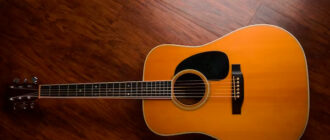
How to Lower the Strings on a Guitar: Acoustic guitars, cherished for their warm tones, may have action that feels too high. Fear not! This post explores how to lower the action on your acoustic guitar, ensuring the perfect playing experience. Whether you’re a seasoned guitarist or a beginner, discover tips to achieve optimal string height and enhance your playing comfort.
Table of Contents
How to Lower the Strings on a guitar?
If you’re a guitar player, you know how important it is to have the right string level or “action” on your instrument. Whether you have an acoustic or electric guitar, there may come a time when you want to adjust the action to make your guitar strings low.
If you find that the action on your guitar is too high, there are several steps you can take to lower it. First, you can adjust the truss rod, which is a metal rod inside the neck of your guitar that helps counteract the tension of the strings. By loosening or tightening the truss rod, you can change the curvature of the neck and subsequently lower the action of the strings.
To adjust the truss rod, you’ll need an Allen wrench. Insert the wrench into the truss rod adjustment hole at the headstock of your guitar and turn it clockwise to tighten or counterclockwise to loosen. It’s important to make small adjustments and check the action frequently to avoid any damage to your guitar.
Another way to lower the action is by adjusting the saddle height. The saddle is the part of the bridge where the strings rest. By lowering the saddle height, you can decrease the distance between the string and the top of the guitar, resulting in a lower action. To do this, remove the strings and then use sandpaper or a file to carefully sand down the bottom of the saddle. Remember to sand evenly and check the action frequently until you achieve the desired height.
What to Do if Guitar Strings Are Too High?
When your guitar strings are too high, you’ll need to adjust the action to bring them closer to the fretboard. If you find that your guitar wires are too high and you want to lower them, there are a few steps you can take.
1. Lower the Bridge Timber:
On an electric guitar, one way to lower the string action is by adjusting the bridge timber. Loosen the string tension, and using a screwdriver, lower the individual bridge saddles to bring the strings down. This method allows you to customize the height of each string to your liking.
2. Loosen the Truss Rod:
The first thing you can try is adjusting the action at the nut. This is where the strings meet the headstock of your guitar. To do this, you’ll need to loosen the strings and use a wrench to turn the truss rod, which will allow you to adjust the height of the strings at the nut.
Be sure to make small adjustments and check the action regularly to avoid going too low. If your guitar has a truss rod, you can use it to adjust the neck’s curvature, which can indirectly affect the string action. Keep in mind that this method requires caution and some knowledge of guitar setup. It’s best to consult a professional if you’re unsure about adjusting the truss rod yourself.
3. Set the Bridge Saddle Height:
On an acoustic guitar, you can lower the string action by adjusting the height of the bridge saddle. Carefully remove the saddle, sand it down slightly, and reinsert it to achieve a lower action. Again, if you’re not comfortable doing this yourself, it’s advisable to seek assistance from a guitar technician.
How Do I Lower the Pitch of my Guitar Strings?

Image by Robbie Down from Unplash
First, you need to identify if your guitar strings are indeed too high. One way to check this is by examining the distance between the strings and the guitar back, also known as the action. A guitar with low action will have strings that are closer to the guitar’s back, while a guitar with high action will have strings that are further away.
To lower the pitch of your guitar strings, you need to adjust the saddle height at the bridge. This applies to both acoustic and electric guitars. Start by loosening the strings and locating the bridge saddle. You can adjust the saddle height using a screwdriver or an Allen wrench, depending on the type of bridge you have. Again, make small adjustments and check the pitch regularly until you find the desired result.
Lowering the pitch of your guitar wires is a slightly different process than lowering the action. While lowering the action focuses on the height of the strings, lowering the pitch refers to changing the tuning of your guitar. Here’s what you can do:
1. Adjust the Tuning Pegs: Each string on your guitar is attached to a tuning peg.
By turning the pegs clockwise, you can tighten the strings and raise the pitch. To lower the pitch, turn the pegs counterclockwise. Remember to make small adjustments and tune your guitar frequently to avoid putting too much stress on the strings.
2. Use a Capo:
If you find that your strings are loose and have a tendency to go out of tune, you can use a capo to raise the pitch. A capo is a device that clamps onto the neck of your guitar and effectively shortens the length of the strings. This can help increase tension and bring the pitch back up.
How Do You Adjust the String Height on a Guitar
To adjust the string height on a guitar, you need to consider both the action at the nut and the action at the bridge. By making small adjustments to these areas, you can achieve the desired string level. Remember, the action at the nut is adjusted using the truss rod, while the action at the bridge is adjusted by altering the saddle height. Take your time and make sure you’re satisfied with the results before moving on.
Whether you have an acoustic guitar or an electric one, adjusting the string level, also known as the action, is a relatively straightforward process. One way to do it is by turning the truss rod, a metal rod that runs inside the neck of the guitar. By tightening or loosening the truss rod, you can raise or lower the action at the nut end of the neck. This will affect the height of the strings at the first fret and ultimately the overall playability of your guitar.
Adjusting the string level on a guitar is crucial for achieving optimal playability. The height at the first fret is particularly important, as it sets the foundation for the rest of the fretboard. Check the string height at the first fret. Press down the string at the first fret and observe the clearance between the string and the top of the fret. A good rule of thumb is to have a small gap, about the thickness of a business card.
Can You Adjust String Height On Acoustic Guitar?
Absolutely. You can adjust the string height on an acoustic guitar just as you would with an electric guitar. The process involves adjusting the action at the nut and the action at the bridge, similar to what we discussed earlier. The saddle is the piece located at the bottom of the guitar bridge, and by raising or lowering it, you can adjust the height of the strings at the bridge end. This will have an impact on the action of the acoustic guitar.
Does String Height Affect Tone?
Yes, string height can affect the tone of your guitar. When the strings are too high, it can be harder to press them down onto the frets, resulting in a less resonant sound and potential intonation issues. On the other hand, if the action is too low, you may experience buzzing or fretting out. Finding the right balance is crucial to ensure optimal tone and playability.
Lowering the action on your acoustic guitar can have a positive impact on the tone. When the action is too high, it can result in poor intonation and a lack of sustain. On the other hand, having a higher action can give you more sustain and resonance but may require a bit more finger strength to play. Finding the right balance between playability and tone is crucial for every guitarist.
How to Lower the Action on an Acoustic Guitar

Image by Mark Timberlake from Unplash
To set the action on your acoustic guitar, you need to focus on the interaction between the strings and the frets. If your strings are too high, you can follow these steps to lower the action and improve your playing experience:
1. Loosen the Strings: Start by loosening the strings to relieve the tension on the neck. This will make it easier to adjust the action.
2. Check the String Height at the Nut: The guitar nut, located at the top of the neck, plays a crucial role in determining the string level. If you want to lower the action, you might need to file the nut slots slightly lower. Be careful not to file too much, as it can cause buzzing or intonation issues.
3. Adjust the Bridge Height: The bridge of your guitar also affects the action. Acoustic guitars usually have an adjustable bridge saddle that can be raised or lowered. If you want to lower the action, you can sand down the bottom of the saddle to make it a little lower. Remember to make small adjustments at a time and check the action frequently.
4. Utilize the Truss Rod: The truss rod is a metal rod inside the neck of the guitar that helps counterbalance the string tension. If your action is still too high after adjusting the nut and bridge, you can try adjusting the truss rod. However, this is a delicate process and should be done with caution. If you’re unsure, it’s best to seek professional assistance.
Tips for Adjusting Guitar String Height
Here are some tips to keep in mind when adjusting the action on your acoustic guitar:
- Take your guitar
- Measure the action: Use a string action gauge to measure the height of the strings above the 12th fret. Check your current action and determine whether you want to lower or raise it. This will give you a baseline to work from and help you make precise adjustments.
- Loosen the strings: Before making any adjustments, it’s essential to loosen the strings. This will prevent any unnecessary tension and allow for smoother adjustments.
- Make small adjustments: When adjusting the truss rod or sanding down the saddle, make small changes at a time. This will prevent any drastic alterations and allow you to fine-tune the action.
- Check and retune: After each adjustment, tune your guitar and check the action. Make sure your guitar is in tune before making any adjustments. This will give you a better understanding of how each change affects the playability of your guitar.
- Use a guitar tuner to check the pitch after each adjustment.
- Measure your action at different points along the neck to ensure consistency.
- If your action is too high, you’ll need to adjust the action at the bridge and/or the nut.
- To lower the bridge action, you may need to remove the strings and adjust the saddle height.
- Remember to loosen your strings before making any adjustments.
- Keep your guitar in tune while adjusting the action. This will give you a more accurate idea of how the changes affect the playability.
- Check your action at different points along the neck, not just at the first fret. This will help you identify any inconsistencies and ensure a more balanced action.
- If your guitar saddle is too high and needs adjustment, it’s recommended to remove the strings first. This will prevent potential damage to the strings or the guitar itself.
- When adjusting the string level, make sure to retune the strings after each modification to ensure proper tension and intonation.
- Experiment with different gauge strings to find the perfect balance between playability and tone.
- Use your string winder: A string winder can help you change strings quickly and efficiently, saving you time and effort.
- Check the string height at the 12th fret: The 12th fret is a good reference point for checking the action. Measure the distance between the bottom of the strings and the top of the fret at the 12th fret to ensure an even action across the fretboard.
- Check the bottom of the string: Look closely at the bottom of the string and observe the distance between the string and the first fret. If the gap is too big, you’ll need to lower the action.
- Test and fine-tune: After making adjustments, play your guitar and see how it feels. If the action is still too high, you can repeat the steps and go a little lower each time until you find the perfect balance.
Remember, each of the six strings may require individual adjustments. Pay attention to the gap between each string and the first fret, as well as the middle strings and the higher frets. Finding the right action for your playing style is crucial for comfort and optimal sound.
While it’s important to achieve the desired action, be cautious not to lower it too much. If the action or string height becomes too low, it can lead to buzzing or even string fretting out. Finding the right balance is key.
If you’re unsure about making these adjustments yourself, it’s always best to consult a professional guitar technician who can provide expert advice and ensure your guitar plays at its best.
Warnings
- Be careful when adjusting the truss rod as it can affect the stability of your guitar neck.
- Avoid making drastic adjustments to the action as it can lead to string buzz or other issues.
- If you’re hesitant to make adjustments yourself, it’s always a good idea to consult a professional guitar technician. They have the expertise and knowledge to ensure that your guitar’s action is properly adjusted without causing any damage.
- If you’ve been adjusting the neck relief of your guitar, you may need to retune your guitar before you test the action at the nut. If your strings aren’t at the correct tension your measurement will be off.
- Acoustic guitars typically need slightly higher action than electric guitars.
- If you’re getting a lot of fret buzz when you play your guitar, you’ve got your action too low. If it’s not comfortable to play or you’re having trouble fretting strings, you may have it set too high. However, some players may prefer a slightly higher or lower action based on their technique and desired tone.
- If your bridge height reading is incorrect, it cannot be changed. The height of the saddle is determined by sanding material off the bottom of the saddle surface using a sanding board. Look for any hidden shims under the saddle that could skew the reading.
Conclusion
In conclusion, lowering the action on your acoustic guitar can greatly enhance your playing comfort and overall tone. By adjusting the truss rod and saddle height, you can achieve the perfect balance between playability and sound quality. Remember to take your time, make small adjustments, and always check your guitar’s action after each change. With a little patience and practice, you’ll be able to find the right action height that suits your playing style.
Whether you want to lower or raise the action, following the steps outlined above will help you achieve the desired results. By finding the perfect string level, you’ll be able to play your guitar comfortably and enjoy optimal tone.
By following the tips and techniques outlined in this blog post, you’ll be well on your way to achieving the desired low action and unlocking the full potential of your instrument. So grab your guitar, take your time, and enjoy the process of fine-tuning your playing experience.
While adjusting the action on your acoustic guitar can greatly improve your playing experience, it’s important to exercise caution. If you’re unsure about making any adjustments yourself, it’s always advisable to seek professional help.
Note: “Action of an acoustic guitar” can also be referred to as “string height”, “set the action”, or “adjust the string height”. Similarly, “guitar nut” can be replaced with “nut,” “bridge height” with “saddle height,” and “adjustable truss rod” with “truss rod and nut slot heights.”






